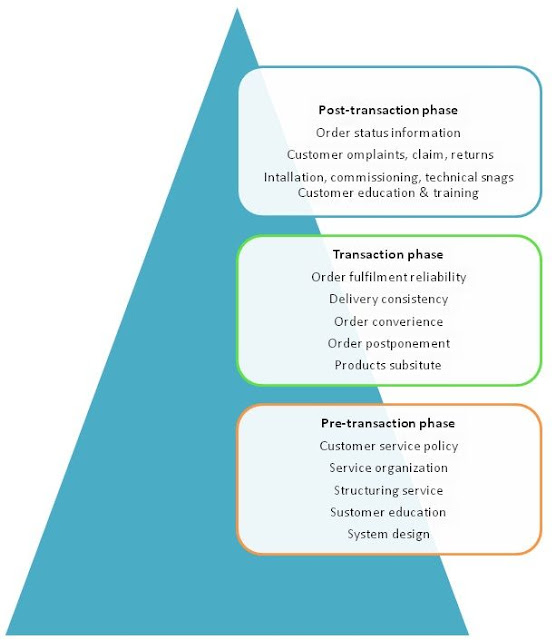Customer Service (Pre-Transaction Phase)
Customer service is the measure of how the logistics is creating the time and place utility for a product. The meaning of customer service varies with the organization the product it is marketing and the transaction phase it is undergoing the buyer looks for value for the money he is spending, while the seller, in delivering superior customer service, looks for a trade-off between cost and customer satisfaction. Hence, customer service depends on the phase of the transaction it is passing through. There are three phases associated with the exchange process. The degree of importance of each phase varies with the organization and depends on the product and customer requirements.
 |
| http://business-entrepreneurshipall.blogspot.com |
Read also: Transaction phase
Pre-transaction phase
This phase is more related to policy for defining the service level and related activities in qualitative and quantitative terms. It is a non-routine activity. It gives the guidelines to the operating people regarding the dimensions and limitations on customer service activities of the firm. The pre-transaction phase is a creation of the service platform to serve the customer, so as to build credibility in the market and rate a good image among the existing and prospective customers. This is an important phase of the exchange process, which will help to mold the organization toward customer orientation and in turn influence the perception of the firm in the mind of the customer. Typically, the following are important elements of the pre-transaction phase.
Customer service policy statement in written form
This will indicate the service standards of the firm. For example, Caterpillar, one of the world’s leading construction equipment manufacturing companies, makes a policy commitment to deliver spare parts to their customer within 24hours of the placement of order . Further, they commit to offer free supply, in case of the parts reach their destination after the stipulated delivery period. In this phase, the firm will have to evolve a policy framework for performance measures, evaluation methods, reporting structure, and the reward structure.
Read also: Global Distribution
Organization building
For implementing the policy directives on customer service, the firm should formalize the porting structure, delegate authority, and allocate responsibility. The contact person’s name and contact number needs to be communicated to the customers for information on order status, dispatch details, warranty claims, and so forth. The contact person is to be delegated with full authority to make decision on customer services within his/her domain and is made accountable for the action he is taking. A proper reward system will motivate the employee involved in customer service to effectively and efficiently interface with the customer.
Structuring the service
The basic structure of the service depends on customer expectations, industry standard, and the service standard the firm would like to keep. The firm marketing capital goods may evolve a service structure to extend lifetime product service commitments for the supply of spares, irrespective of continuous product and technology upgrades at its end. The supplier may extend a free periodic product check-up service to clients to gain a competitive edge. In such case he/she may absorb all service-related costs as a value-added free service to the client. In the maturity stage of the product life cycle, when competition is fierce the firm needs to customize the service to strategic clients or to a section of clients in the niche segments.
Read also: Distribution Channel
Customer education
This is required for minimizing customer complaints on product deliveries, product operations and maintenance, spare parts inventory requirements and maintenance, freight charges, transit damages, and more. Customer education is done through manuals, training, seminars and workshops.
System design
System configuration should take care for active customer service to answer all possible queries in the customer’s mind before placing an order. The system may be manual or fully automatic as in e-commerce. However, a prerequisite of the system in a competitive environment is responsiveness to customer requirements and the flexibility to take care of unplanned events if you want to build a strong customer service.